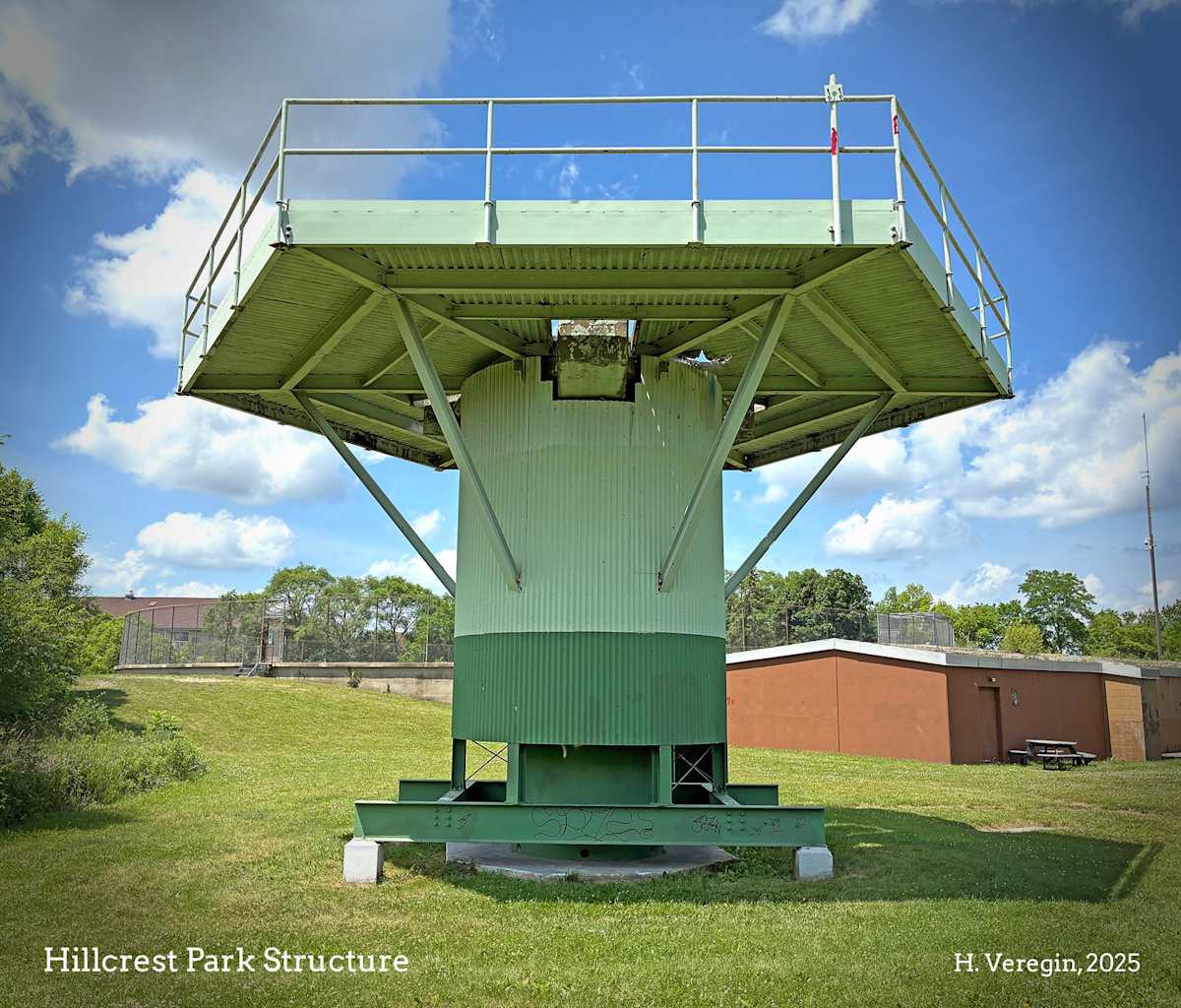So long, Mom
I’m off to drop the bomb
So don’t wait up for me
- Tom Lehrer, So Long, Mom
(A Song for World War III), 1965
What is this place? It’s a public park, but there are no swings or slides. A few grim cinder-block buildings are scattered on the grounds. There’s a large, circular concrete pad behind a chain-link fence. Nearby, a hexagonal metal platform sits atop a cylindrical tower. It’s encased in corrugated metal painted in vile shades of military green.
The mystery is solved by a metal plaque next to the flagpole a few hundred feet from the platform:
From 1956-64 the U.S. Army operated a Nike Missile site at this location, now known as Hillcrest Park. The mission was to defend the skies of Milwaukee against enemy bomber attack. Barracks and radar facilities were located here. At Missile Park, one mile south, the Nike Ajax and Hercules missiles were kept in underground storage pits.
Missiles in Waukesha?
The US Army’s Nike missile program evolved out of Cold War paranoia over a Soviet attack on the United States by long-range aircraft carrying nuclear bombs. The Nike missile sites – about 300 in 29 states at the height of the program – surrounded major cities and military bases across the country. There were eight sites surrounding Milwaukee, including three in Waukesha County: Hillcrest Park (designated M-74), Muskego (M-64) and Menominee Falls (M-86).
There were also five missile sites in Milwaukee County, including one at the current Summerfest location (M-20). Two were in the northern part of the county at River Hills (M-02) and northwest Milwaukee (M-96), one was at Cudahy near Lake Michigan (M-42) and one was at Hales Corners (M-54). These sites formed a semicircle around the metro Milwaukee area. [1]
It's hard to imagine the fear that gripped the nation in the 1950s. This was the era of civil defense preparation, fallout shelters and “duck and cover” drills in schools. Following the only wartime use of nuclear bombs – the US bombing of the Japanese cities of Hiroshima and Nagasaki in August 1945 – the US enjoyed a monopoly on nuclear weapons. But not for long. In 1949, the USSR detonated its first nuclear (atomic) bomb, and in 1953, it detonated a hydrogen bomb (H-bomb), magnitudes larger in explosive power. The Soviet H-bomb was thought by US military strategists to be beyond the technical capabilities of the USSR at the time.
Nike missiles were part of a civil air defense program known as ARADCOM (Army Air Defense Command). Even before the end of World War II, it was clear to the Army that conventional anti-aircraft defenses – which consisted mainly of radar-assisted batteries of 90mm guns – were no longer effective. Modern aircraft flew too high and too fast. The Army began surface-to-air missile development in the 1940s. The various components of the system were developed by military contractors, including Bell Laboratories, Western Electric, McDonnell Douglas and Aerojet Corporation. [2]
By 1953 the Nike system was operational. The first Nike site was at Fort Meade, Maryland. Other early sites included Washington, New York, Chicago, and other big cities. Locations were based on calculations by military strategists to deter both mass attacks from one direction and simultaneous attacks from multiple directions.
Nike was the Army’s first operational guided missile for air defense. It was a complex system requiring sophisticated equipment and plenty of personnel. Hillcrest Park housed M-74’s battery control area. Close to one hundred soldiers were stationed there. The launch area, where missiles were stored and fired, was a mile to the south in what is now known as Missile Park. Back then, the area was more rural than it is today.
The City of Waukesha’s Hillcrest Park website [3] provides a virtual tour of the remnants of the M-74 Nike site. These include a fallout shelter (one of the cinder-block buildings), the target-tracking radar platform (the green metal platform), supports for the high-power long-range acquisition radar (reconfigured into a sort of bandshell), the mess hall, a basketball/volleyball court and a helicopter pad. Many other structures, including the barracks, headquarters building, target ranging radar, communications tower and equipment buildings, are no longer in existence.
Next week, Oddsconsin will examine the history of the M-74 site.
Sources:
[1] Joy Powers, Was Milwaukee Once Surrounded by Nuclear Weapons? WUWM 89.7 (Milwaukee’s NPR), Feb. 12, 2021. https://www.wuwm.com/regional/2021-02-12/was-milwaukee-once-surrounded-by-nuclear-weapons
[2] Department of Defense and Department of the Interior, Last Line of Defense, 1996. Available online at https://ed-thelen.org/pics/LastLineDefense-Illinois.pdf
[3] Hillcrest Park, City of Waukesha. https://www.waukesha-wi.gov/_T10_R125.php
